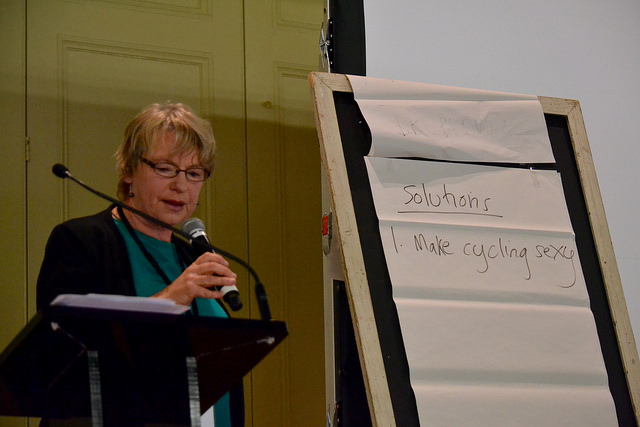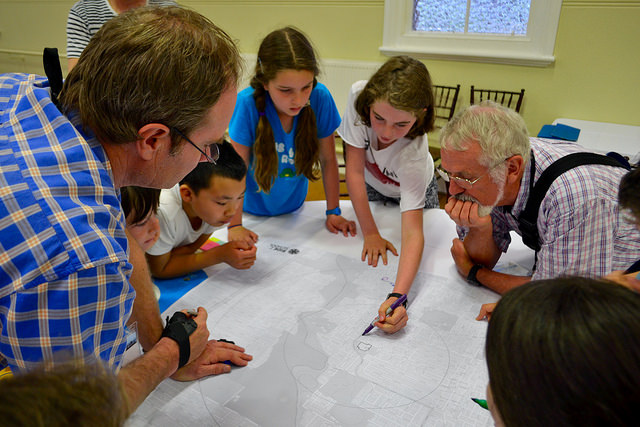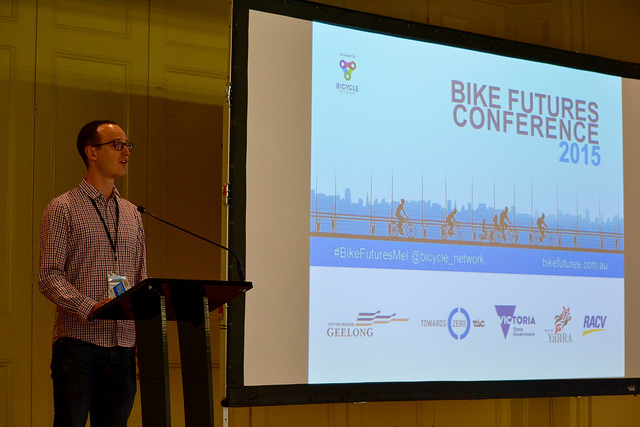Over 150 experts in urban planning, active travel and bike advocacy met at the annual Bike Futures Conference this week to discuss and dissect the challenges of becoming a nation of bike riders. Michael Hobbs reports.
The three day conference themed on ‘overcoming barriers to bike riding’ had delegates pedalling through Melbourne on Monday, before hearing from leaders of the bike world on Tuesday and then all together workshopping bike-friendly ideas on Wednesday.
The bike tours showcased Melbourne’s bike infrastructure highlights along the Capital City Trail, considered future developments at Docklands and visited inner-north primary schools.
On day two, Bicycle Network’s Chief Executive Officer, Craig Richards, opened the conference by taking the audience “back to the future” and declaring the conference a great opportunity to discuss what kind of future we want for bike riding. “Set a diary reminder for the 21st of October 2045,” was his challenge.
Keynote speaker, Kyle Wagenschutz showed how one of America’s worst cities for bike riding, his home town of Memphis, could in the space of five years be transformed into one of its most bike-friendly. As the Bike/Pedestrian Coordinator for the City of Memphis and self-confessed “bike nerd”, Kyle overcame a city with a proud automobile tradition by successfully engaging community advocates, getting a pro-bike mayor elected and remaining rational in the face of dissenters. By winning approval for several small infrastructure projects, negative attitudes shifted as the benefits of bike riding went on display for local businesses and the community.
Kyle’s inspiring case study provided the perfect bridge into the changes occurring in New Zealand’s bike riding landscape. National Cycling Manager for the NZ Transport Agency, Dougal List, said explaining “the why of what you’re doing” and gaining a “social license” from the public was key to getting results for bike riders.
Dougal said the bike riding message must connect with those who don’t ride a bike. He said “a nice place to live” was something that resonated with the wider community and should be pushed. He noted New Zealand’s cycle tourism industry was also important for securing financial commitment from business and political leaders. With $380 million to spend on bike riding over the next three years and a government focused on results not strategy, Dougal set a benchmark for Australia’s bike riding community to aspire to, if not to envy.
Senator Janet Rice of the Australian Greens provided an honest and insightful look into why bike riding still isn’t part of the transport decision-making process at the highest level. She succinctly put it down to three reasons:
- Bikes are small – in stature, in population and in terms of finances;
- Bikes are misrepresented – 16% of road hospitalizations are cycling related;
- The political leadership isn’t there – politicians don’t like congestion but keep funding roads.
 Her solutions were equally pointed.
Her solutions were equally pointed.
- Make cycling sexy;
- Make decision makers accountable to transport spending;
- Get political.
As sessions splintered across different rooms, talks diversified into topics ranging from the gender gap in cycling and route selection, even to whether Taylor Swift would ride to school. Rayoni Nelson from Vic Health provided worried parents the strategies they needed to their children more independent active travellers while Bicycle Network’s Chris Carpenter, unveiled a Bike Account designed to “unlock years of riding data.” The visual account similar to Copenhagen’s 11-year running bike account, analyses communities on a national scale showing who’s succeeding as bike riders, who’s falling behind and why.
In a busy room backstage, councils, schools and advocates converged to nut out new approaches to encouraging children to actively travel to school. Bicycle Network’s National Ride2School Manager, Jeff McPhan, said “it was amazing to have all the key players from councils and schools in the one room working together.”
Day One wrapped up with a panel session themed on “the one thing we must do.” Much like a bike riders’ version of Q&A, cycling organisation leaders took questions from a highly informed and passionate audience. The atmosphere swayed from frustration to optimism, to poetic as the City of Yarra’s Jane Waldock described how the Yarra River sparkles under the willows as she rides home each day.
The third and final day was all about collaboration—the very thing that much of day two demanded for the future of bike riding. Six workshops brought delegates together to apply their ideas and come up with practical solutions for real world problems. Some groups came up with plans to build cycling paths above level crossings and others emerged with guides for behaviour on shared paths.
 But perhaps the brightest spark of the day came from 20 Brunswick East Primary School students who told adult riders just what it was like for them travelling to school each day. As part of the ‘Active Paths’ workshop facilitated by Ride2School Coordinator, Nathan Stevens, they physically drew their route to school on a map and marked out the fun parts, the scary parts and potential places to all start from. The clarity and detail of the children’s way to school was remarked upon by many, revealing the need “for the child’s voice to be heard” as one audience member later put it.
But perhaps the brightest spark of the day came from 20 Brunswick East Primary School students who told adult riders just what it was like for them travelling to school each day. As part of the ‘Active Paths’ workshop facilitated by Ride2School Coordinator, Nathan Stevens, they physically drew their route to school on a map and marked out the fun parts, the scary parts and potential places to all start from. The clarity and detail of the children’s way to school was remarked upon by many, revealing the need “for the child’s voice to be heard” as one audience member later put it.
The notion of listening to new voices was a fitting place to conclude the 2015 Bike Futures Conference. A message for bike riding enthusiasts to now widen the conversation and bring the rest of Australia along with them.
View pictures of Bike Futures Conference 2015 on Flickr
Learn about what Bike Futures offers
Ride On content is editorially independent, but is supported financially by members of Bicycle Network. If you enjoy our articles and want to support the future publication of high-quality content, please consider helping out by becoming a member.

